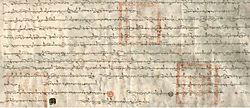Treaty of friendship and alliance between the Government of Mongolia and Tibet facts for kids
Tibet and Mongolia signed a treaty called the Treaty of friendship and alliance between the Government of Mongolia and Tibet on February 2, 1913, at Urga (now Ulaanbaatar). Today, we are not sure if the treaty can be used or not.
Legal issues
The Qing Dynasty ended in 1911. After this, both Tibet and Mongolia were independent. Both had a lamaist head of state. The Republic of China did not see them as independent. In the treaty, both Mongolia and Tibet said they would see each other as independent, and help each other in war.
The people who signed for Mongolia were foreign minister Da Lama Ravdan and General Manlaibaatar Damdinsüren. Those who signed for Tibet were Agvan Dorjiev, Chijamts, and Gendun-Galsan, who lived in Tibet. Dorjiev was a Buryat, a citizen of Russia. For this reason, the treaty may not be legal. The 13th Dalai Lama denied that he had let Dorjiev sign a treaty with Mongolia. More importantly, neither the cleric nor the Tibetan government has ever signed any treaty. The Russian government said that Dorjiev was Russian. He could therefore not act as a diplomat for the Dalai Lama. The Mongolian text of the treaty has been published by the Mongolian Academy of Sciences in 1982.
Most other people still did not see Mongolia or Tibet as independent. They said that these areas belonged to China. Western powers had made treaties with the Qing Dynasty, and China had said it would honour these treaties. If they had recognised either Tibet or Mongolia, these treaties would have become invalid. The main Western powers were the United Kingdom and Russia. Both feared that if they saw the countries as independent, they could come under the influence of the other western powers. In their opinion, that situation was worse than if China controlled both of them, because China was weak.
Solutions
British negotiators at the Simla Convention heard about the treaty and got very suspicious. They feared that Russia might use the treaty to gain more influence in Tibet. In the end, China did not sign the Simla Convention. Instead, a very similar treaty was signed by Mongolia, China, and Russia on 25 May 1915. This treaty was called the tripartite Treaty of Kyakhta. The agreement stated that Mongolia was completely autonomous in internal matters and that Russia had certain privileges in Mongolia. At the same time it said that Mongolia was in fact a part of China.
See also
 In Spanish: Tratado de amistad y alianza entre el gobierno de Mongolia y el Tíbet para niños
In Spanish: Tratado de amistad y alianza entre el gobierno de Mongolia y el Tíbet para niños


